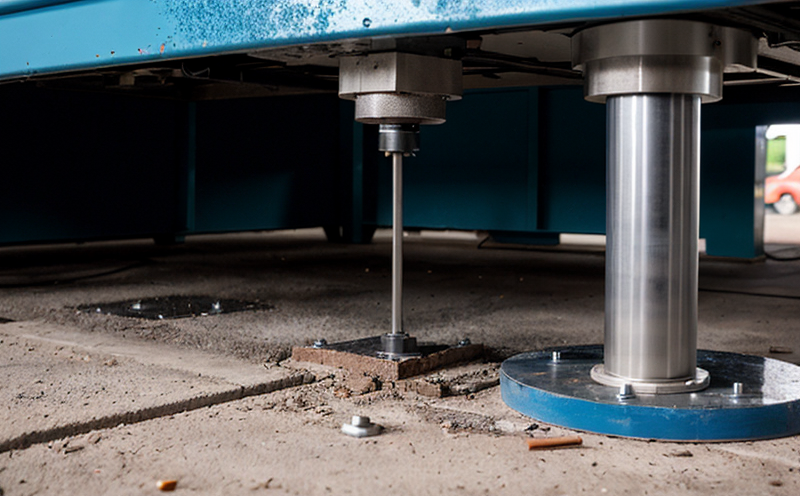ASTM E837-20 Hole Drilling Strain-Gage Method for Residual Stress
The ASTM E837-20 standard is a widely recognized method for assessing residual stresses in materials and structures. This technique, often referred to as the hole drilling strain-gage method (HD-SGM), provides a non-destructive approach to measuring internal stresses within components manufactured via additive manufacturing (AM) processes such as 3D printing.
The ASTM E837-20 standard is particularly valuable in sectors where precision and reliability are paramount, including aerospace, automotive, medical devices, and defense. In these industries, the presence of residual stress can significantly affect the structural integrity, fatigue life, and performance of components. By employing this method, engineers and quality managers ensure that products meet stringent design specifications and regulatory requirements.
The process involves drilling a small hole into the component under test, typically using a strain gage to measure the resulting elastic strains as material is removed during the drilling process. The relationship between these strains and the internal stresses within the component allows for precise determination of residual stress levels. This information is critical for optimizing manufacturing processes, improving product quality, and ensuring compliance with international standards.
One of the key advantages of the ASTM E837-20 method is its ability to provide accurate residual stress measurements without compromising the integrity of the component. This non-destructive testing approach minimizes potential damage that might occur during other testing methods. Additionally, it offers high spatial resolution, allowing for localized stress analysis which can be crucial in identifying specific areas where improvements are needed.
The ASTM E837-20 standard is supported by advanced instrumentation and software tools designed to enhance the accuracy of strain-gage readings. These tools include sophisticated data acquisition systems capable of processing complex signals from multiple gages simultaneously, ensuring precise stress calculations. Furthermore, modern testing facilities equipped with these technologies allow for comprehensive analysis of components across various geometries and materials.
It is important to note that while the ASTM E837-20 method provides valuable insights into residual stresses within 3D printed parts, it does have limitations. For instance, the presence of surface roughness or geometric irregularities can affect measurement accuracy. Therefore, proper specimen preparation and calibration are essential steps in ensuring reliable results.
By adhering to best practices outlined in the ASTM E837-20 standard, laboratories and manufacturers can achieve consistent, repeatable measurements that contribute significantly to maintaining quality standards across diverse applications. Understanding these nuances is crucial for those involved in additive manufacturing research and development efforts aimed at improving product performance and durability.
For more detailed information on how the ASTM E837-20 standard applies specifically within your industry or project scope, contact our technical experts who can provide tailored guidance based on specific requirements and challenges faced by organizations operating in this field.
Applied Standards
The ASTM E837-20 hole drilling strain-gage method for residual stress utilizes several key standards that guide its implementation. These include:
- ASTM E837-20: Standard Practice for Determining Residual Stresses by the Hole Drilling Method.
- ASME PCC-1: Performance Criteria for Pressure Vessels and Components of Power Boilers - Section I, Division 1.
- ISO/TS 24586-3: Additive Manufacturing Technologies - Quality Management and Assurance in AM Processes - Part 3: Process Monitoring and Verification Techniques.
The application of these standards ensures that the testing procedure adheres to established protocols, thereby enhancing reliability and consistency across different laboratories. Compliance with ASTM E837-20 also facilitates interoperability between various facilities and promotes trust in the accuracy of reported results among stakeholders involved in AM processes.
Why Choose This Test
- Precise measurement of residual stresses within 3D printed components without compromising integrity.
- Non-destructive nature allowing for repeatable testing on the same specimen multiple times if necessary.
- Compliance with international standards ensuring reliability and consistency across different laboratories.
- Advanced instrumentation providing accurate strain-gage readings even from small areas of interest.
The ASTM E837-20 method is ideal for industries requiring stringent quality control measures to ensure product performance and safety. Its ability to pinpoint specific regions experiencing high residual stress levels makes it particularly useful in optimizing manufacturing processes, improving product reliability, and ensuring regulatory compliance.
Customer Impact and Satisfaction
By leveraging the ASTM E837-20 method, customers benefit from enhanced confidence in their products' structural integrity. This translates into improved reputation among clients who value reliable performance and long-term durability. Additionally, the non-destructive nature of the test allows for continuous monitoring during development stages, facilitating timely adjustments to manufacturing techniques as needed.
Positive customer feedback highlights the accuracy and reliability offered by this testing approach. Many users report increased efficiency in identifying critical areas requiring attention, leading to reduced costs associated with rework or scrap materials. Overall satisfaction stems from knowing that their products meet rigorous standards while maintaining competitive advantages in the market.





